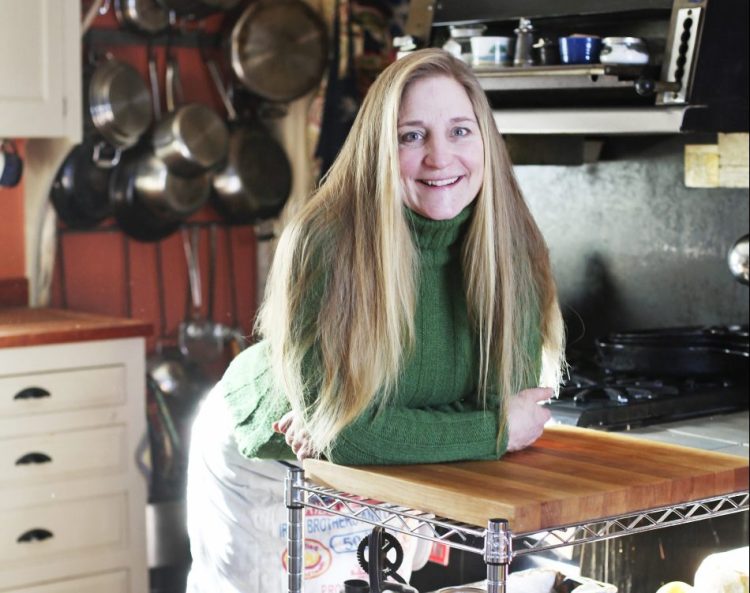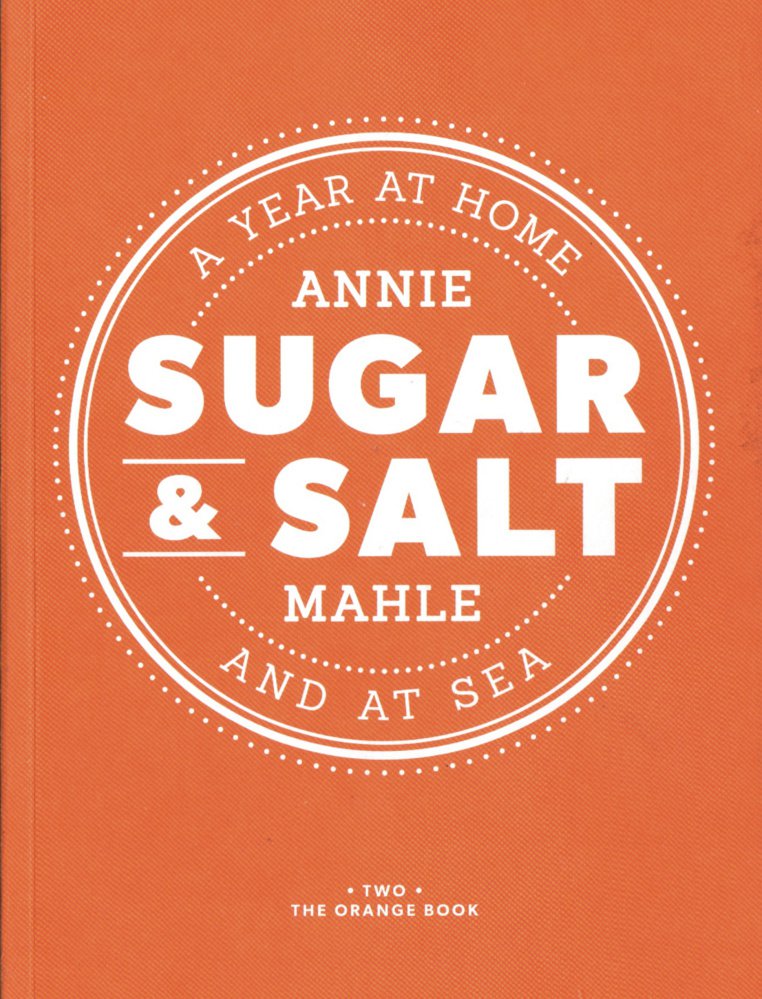At 21, newly minted college graduate and Michigan native Annie Mahle tacked left. She needed an advance degree to make a career for herself in psychology, “but I could not make myself look at Ph.D. programs, take the tests.”
“I knew I needed to take a break from school,” she continued. “I said, ‘I am going to travel. I am going to learn how to sail and I am not calling home for money.’ It’s the first time I made an intentional decision about my own life that didn’t have to do with anybody else’s desires for me.”
She came to Maine, where she found work on a windjammer. In short order, she fell in love with Jon, the man who would become her husband. And she fell in love with cooking. Thus is one’s life course charted.
Today, Mahle and Jon Finger, co-captain the J.&E. Riggin and their teenage daughters serve as crew. Every summer for the last 20, they have sailed the schooner in and around Penobscot Bay, with Mahle cooking lavish meals (local eggs, homemade breads, curried lamb and lentil stew, homemade pies…) over a wood stove for as many as 30 vacationers. Winters, the family lives in Rockland. Over the years, Mahle has written cooking columns for the Portland Press Herald – The Maine Ingredient and Sea Food – and she recently self-published her second cookbook in the series, “Sugar & Salt: A Year at Home and at Sea.”
This interview has been edited for length and clarity.
Q: When did your interest in cooking develop?
A: I didn’t start being interested in food, really interested, until I came out to work on the windjammers, and I saw pies and jams being made by hand. The more I saw things at their origin, made from scratch, the more interested I became in well, how do you make your own vanilla? How do you make mustard? How do you make sauerkraut? And they taste so different! It wasn’t until I came to Maine did that ignite a food curiosity and lifelong investigation into this.
Q: You’ve just written your third cookbook. Do you use cookbooks yourself?
A: I use cookbooks as inspiration. I have a lot of them. The books I buy now are very niched – fermentation or pasta making by a master or sourdough bread. Things where I want to delve deeper into a particular subject. I love looking at general cookbooks and old cookbooks, but I don’t use them in the way that I used to.
I’m sort of constitutionally unable to follow a recipe at this point. I’m always thinking, ‘Oh, interesting, I wonder if I just tweaked it here, how would it be better or what would happen?’ The other thing is that’s something that I have to do, because on the boat there are numerous times when I thought we had enough of some ingredient, but I used it to cook something else, so I’m constantly substituting one ingredient for another because I can’t go to the grocery store and get it.
Q: Do you have a favorite cooking task?
A: I love to make bread. Bread is baking. It can be very precise. At the same time you are dealing with a live organism. You need to be really present when you are making bread.
Q: Some people say there is a divide between bakers and cooks. Do you think so? Which do you consider yourself?
A: Bakers are people who feel most satisfied following the rules. They are more precise, more accurate. Cooks are more fluid, more creative, more flexible but then not always consistent. I am definitely a cook. That doesn’t mean you can’t do both if you know that about yourself: I know for sure the things I have to do the same every time (when I am baking) and the things that I can change.
Q: So now tell us about a kitchen task you don’t like so much.
A: (Long pause.) It’s really nice if I have somebody cleaning up after me.
Q: What advice do you have for someone cooking on a boat?
A: Keep it simple. Stay organized. And remember cooking for your family is always more nourishing than a machine cooking for your family. There is soul in that. There is heart in that. Honor the effort and the care.
Q: What are the most important provisions to stock on the boat?
A: I always have extra of the basics – flour, butter, sugar and eggs. I never leave the dock without 1½ to 2 times what I need of those ingredients. With the basic ingredients, if I am missing something else, I can still make something.
At home I would never be without greens and eggs. To me, an egg is such an elegant protein, and we have our own chickens so they are the freshest eggs you can possibly have.
Q: Do you cook differently on land than at sea?
A: Not really. The biggest difference is that I’m not cooking for 30 people. At home, I have the hardest time paring down the amount we would eat. And we don’t have a dog so that doesn’t help, either. I suppose the other thing that changes in the wintertime is we eat more simply.
Q: Wait a minute! I thought you have no electricity on the boat? That’s not different?
A: (Loud, long laughter) That’s a good point. It’s funny – I make that transition so seamlessly it doesn’t even occur to me. I cook on a wood stove on the boat, so the biggest difference is I don’t have to get up at 4:30 a.m. at home to light the wood stove. (More laughter.)
There are a lot of things you can do to control the heat of a wood stove, but like baking bread, wood heat or heat from a fire is an alive being. It ebbs and it flows and it needs tending. It definitely needs paying attention to. I love it. I love the smell of it. I love the warmth of it. I love the glow of it. I love that stove and the flavor that I can evoke from it.
And at the same time, I am grateful to have a gas oven at home when I am just cooking for three or four people. On the boat, cooking is my full-time job, well, one of 10 jobs, whereas at home cooking is not nearly as central to my daily life. It’s a part of, mixed in with, writing and taxes and balancing the checkbook.
Q: I’m curious about the title of your cookbook series – “Sugar & Salt: A Year at Home and at Sea.” Where did that come from?
A: My life is spent on the ocean for half of the year, so that’s the salt, and then on land the other half of the year, so sugar – sugar cane. These are really basic ingredients that are part of our palate, the palate of life and the palate of food.
BLIZZARD CARBONARA
Annie Mahle says this is one of her favorite recipes in her new book, the second in the series “Sugar & Salt: A Year at Home and at Sea.” We interviewed her just as a blizzard was bearing down on Maine. “This is just about the exact time of year and circumstances that I made that recipe,” she told us.
To get refrigerated eggs to room temperature, place the eggs in a bowl of warm water while you prep the rest of your ingredients. If the hot pasta doesn’t set up the eggs, try returning the pan to the residual heat of the burner – without turning it on.
Mahle likes to serve the carbonara with her Beet, Pear and Cranberry Salad with Shaved Asiago.
Serves 4 to 6
1 pound spaghetti
4 large eggs, room temperature
6 ounces (about 3/4 cup lightly packed) grated Parmesan cheese, plus more to serve
2 tablespoons extra-virgin olive oil
3 ounces prosciutto, sliced into 1/4-inch strips
2 tablespoons minced garlic
1/2 cup minced fresh Italian parsley
1/2 teaspoon kosher salt
Several grinds fresh black pepper
Bring a large pot of salted water to boil. Add the pasta and cook until al dente according to package instructions.
Beat the eggs with a fork in a small bowl until they are frothy. Add the cheese to the eggs and beat again to mix. Set aside.
Meanwhile, heat the oil over medium-high heat in a large skillet. Add the prosciutto and sauté for 1 minute. Add the garlic and remove the pan from the heat. After a minute, add the parsley.
When the pasta is done, drain it and immediately add it to the skillet with the prosciutto and garlic. Add the egg mixture, season with the salt and pepper, and gently but quickly incorporate all with rubber-tipped tongs or a wooden spoon.
The process of mixing the pasta should take less than 1 minute. Serve immediately with extra grated Parmesan cheese and black pepper.
BEET, PEAR AND CRANBERRY SALAD WITH SHAVED ASIAGO
Also from Mahle’s new book, this salad and the dressing below.
Serves 4 to 6
8 cups (about 8 ounces) lightly packed spinach
2 tablespoons good quality extra-virgin olive oil
2 tablespoons white balsamic vinegar
Pinch kosher salt
Several grinds fresh black pepper
1 recipe Beets with White Balsamic Vinaigrette
1 pear, cored and sliced thinly
1/4 cup dried cranberries
2 ounces (about 1/4 cup) shaved Asiago cheese
Toss the spinach with the olive oil, vinegar, salt and pepper in a large salad bowl. Add the Beets with White Balsamic Vinaigrette. Top with the pear slices, cranberries and Asiago. Serve immediately.
BEETS WITH WHITE BALSAMIC VINAIGRETTE
Makes about 3 cups
1 pound small to medium beets
1 tablespoon good quality extra-virgin olive oil
1 tablespoon white balsamic vinegar
Pinch kosher salt
Several grinds fresh black pepper
Trim the root tips and greens from the beets and wash well. Reserve the greens for another use.
Cover the beets with salted water in a medium stockpot and bring the water to a boil. Boil until the beets are just tender, 30-35 minutes, and drain. Let the beets cool until you are able to touch them. Peel. Cut into quarters or smaller.
Toss the beets with the olive oil, vinegar, salt and pepper in a medium-sized bowl.
Send questions/comments to the editors.





Success. Please wait for the page to reload. If the page does not reload within 5 seconds, please refresh the page.
Enter your email and password to access comments.
Hi, to comment on stories you must . This profile is in addition to your subscription and website login.
Already have a commenting profile? .
Invalid username/password.
Please check your email to confirm and complete your registration.
Only subscribers are eligible to post comments. Please subscribe or login first for digital access. Here’s why.
Use the form below to reset your password. When you've submitted your account email, we will send an email with a reset code.